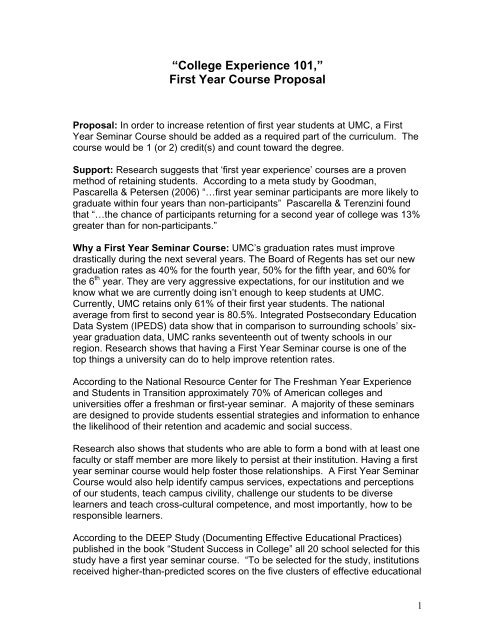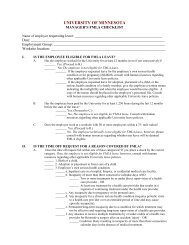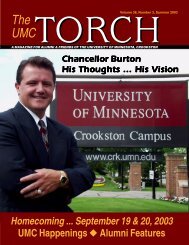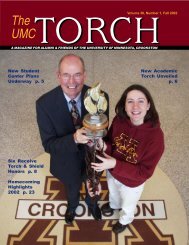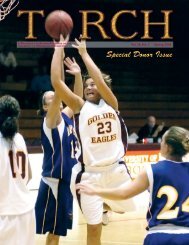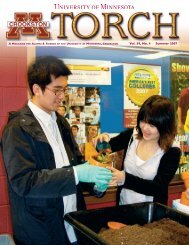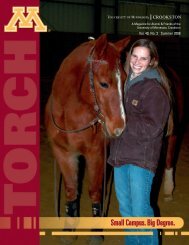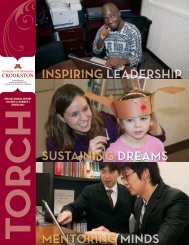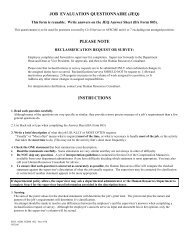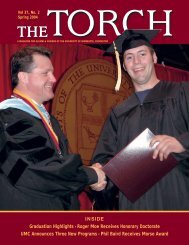âCollege Experience 101,â First Year Course Proposal - University of ...
âCollege Experience 101,â First Year Course Proposal - University of ...
âCollege Experience 101,â First Year Course Proposal - University of ...
Create successful ePaper yourself
Turn your PDF publications into a flip-book with our unique Google optimized e-Paper software.
“College <strong>Experience</strong> <strong>101</strong>,”<br />
<strong>First</strong> <strong>Year</strong> <strong>Course</strong> <strong>Proposal</strong><br />
<strong>Proposal</strong>: In order to increase retention <strong>of</strong> first year students at UMC, a <strong>First</strong><br />
<strong>Year</strong> Seminar <strong>Course</strong> should be added as a required part <strong>of</strong> the curriculum. The<br />
course would be 1 (or 2) credit(s) and count toward the degree.<br />
Support: Research suggests that ‘first year experience’ courses are a proven<br />
method <strong>of</strong> retaining students. According to a meta study by Goodman,<br />
Pascarella & Petersen (2006) “…first year seminar participants are more likely to<br />
graduate within four years than non-participants” Pascarella & Terenzini found<br />
that “…the chance <strong>of</strong> participants returning for a second year <strong>of</strong> college was 13%<br />
greater than for non-participants.”<br />
Why a <strong>First</strong> <strong>Year</strong> Seminar <strong>Course</strong>: UMC’s graduation rates must improve<br />
drastically during the next several years. The Board <strong>of</strong> Regents has set our new<br />
graduation rates as 40% for the fourth year, 50% for the fifth year, and 60% for<br />
the 6 th year. They are very aggressive expectations, for our institution and we<br />
know what we are currently doing isn’t enough to keep students at UMC.<br />
Currently, UMC retains only 61% <strong>of</strong> their first year students. The national<br />
average from first to second year is 80.5%. Integrated Postsecondary Education<br />
Data System (IPEDS) data show that in comparison to surrounding schools’ sixyear<br />
graduation data, UMC ranks seventeenth out <strong>of</strong> twenty schools in our<br />
region. Research shows that having a <strong>First</strong> <strong>Year</strong> Seminar course is one <strong>of</strong> the<br />
top things a university can do to help improve retention rates.<br />
According to the National Resource Center for The Freshman <strong>Year</strong> <strong>Experience</strong><br />
and Students in Transition approximately 70% <strong>of</strong> American colleges and<br />
universities <strong>of</strong>fer a freshman or first-year seminar. A majority <strong>of</strong> these seminars<br />
are designed to provide students essential strategies and information to enhance<br />
the likelihood <strong>of</strong> their retention and academic and social success.<br />
Research also shows that students who are able to form a bond with at least one<br />
faculty or staff member are more likely to persist at their institution. Having a first<br />
year seminar course would help foster those relationships. A <strong>First</strong> <strong>Year</strong> Seminar<br />
<strong>Course</strong> would also help identify campus services, expectations and perceptions<br />
<strong>of</strong> our students, teach campus civility, challenge our students to be diverse<br />
learners and teach cross-cultural competence, and most importantly, how to be<br />
responsible learners.<br />
According to the DEEP Study (Documenting Effective Educational Practices)<br />
published in the book “Student Success in College” all 20 school selected for this<br />
study have a first year seminar course. “To be selected for the study, institutions<br />
received higher-than-predicted scores on the five clusters <strong>of</strong> effective educational<br />
1
practice used by the National Survey <strong>of</strong> Student Engagement (NSSE) “(Kuh,<br />
Kinzie, Schuh, and Whitt, 2005). The five clusters are: level <strong>of</strong> academic<br />
challenge, active and collaborative learning, student interaction with faculty<br />
members, enriching educational experiences, and supportive campus<br />
environment.<br />
Background: Currently, UMC has four courses required <strong>of</strong> all students for<br />
graduation: Composition I, Composition II, Public Speaking, and Computer<br />
Applications <strong>101</strong>0. The first three courses are designed to coincide with the<br />
three Core Components <strong>of</strong> UMC: Communication, Critical Thinking, and Working<br />
with Others. CA <strong>101</strong>0 is tied to UMC’s original technology initiative, but the<br />
majority <strong>of</strong> students now entering UMC graduated after 2000 and most are wellversed<br />
in computer usage. In response, CA <strong>101</strong>0, originally a quarter-long class,<br />
has been reduced to five weeks in length.<br />
Option I: Transform the CA <strong>101</strong>0 course as part <strong>of</strong> an orientation class<br />
that would focus on the transition to college life, expectations, and success.<br />
Advantages:<br />
• CA <strong>101</strong>0 is already one <strong>of</strong> the four required courses, expanding it would<br />
eliminate the necessity <strong>of</strong> adding a fifth required course<br />
• Rapid implementation<br />
• Can incorporate the current requirements <strong>of</strong> CA <strong>101</strong>0<br />
• Already built into schedule<br />
Disadvantages:<br />
• In order to keep class size down to effective minimums (20 max) 15-20<br />
sections would need to be added (true <strong>of</strong> all options). However, if<br />
significant retention gains result, this could be well worth the extra time<br />
and cost.<br />
Option II: Create an entirely new course (a fifth required course) which will<br />
accomplish the same result.<br />
Advantages:<br />
• Less disruption in current system<br />
• <strong>Course</strong> can be designed from scratch<br />
Disadvantages:<br />
• Fifth required course in an already over-burdened schedule<br />
• Teaching load<br />
Option III: Redesign Gen Ed. 1000 or 1001 from a developmental course<br />
required <strong>of</strong> students who meet certain requirements, to a FYS course required <strong>of</strong><br />
all incoming FY students (a fifth required course).<br />
2
Advantages:<br />
• Much <strong>of</strong> the material is being used now<br />
• Can draw on the experience <strong>of</strong> Jim Schaar to design<br />
Disadvantages:<br />
• Would add additional, 5 th required course to program <strong>of</strong> study<br />
Teaching Options:<br />
Option I: Faculty or staff will volunteer to teach a section <strong>of</strong> first year seminar for<br />
$1,000/ semester<br />
Option II: Faculty/staff will be selected and asked to teach a section for<br />
$1,000/semester<br />
Financial Implications:<br />
300 new freshmen with 20 students per section means there would be 15<br />
sections <strong>of</strong> the course. Tuition rates <strong>of</strong> $205 per credit x 20 = $4,100 per class.<br />
The <strong>University</strong> <strong>of</strong> Minnesota, Crookston currently has credit hours that are<br />
equivalent to 1,052 students. Based on the 2003 graduation data taken from<br />
IPEDS, National Center for Educational statistics, we currently graduate only<br />
35.3% <strong>of</strong> our students in six years. This means that almost 65% <strong>of</strong> our students<br />
are not completing in six years, which correlates to 684 students that do not<br />
graduate.<br />
Based on our 2006-07 tuition rates $7,200 (15 credits) per year, plus a student<br />
service fee <strong>of</strong> $368 and technology fee <strong>of</strong> $1000, this equates to a loss <strong>of</strong><br />
$5,860,512 from tuition and fees revenue alone.<br />
$7200 + $1000 + $368 = $8568/year<br />
$8568 x 684 lost students = $5,860,512 lost revenue (does not include room<br />
and board)<br />
The cost to recruit each new student at UMC for the fall <strong>of</strong> 2005 was calculated<br />
at $519 per student. The total cost <strong>of</strong> replacing the 684 non-returning students is<br />
an additional expenditure <strong>of</strong> $354,996.<br />
$5,860,512 lost revenue plus $519 recruiting replacement cost = $6,215,508<br />
3
CLASS STRUCTURE OPTIONS:<br />
There are many options available on class structure. Below are options<br />
that other campuses have utilized and can be discussed further.<br />
Placement Options:<br />
Option I: Random placement<br />
Option II: Selected placement (for example, according to major, etc).<br />
Option III: Random placement with possible cohort related major, admission<br />
status, first generation, non-traditional, etc.<br />
Extremely Important<br />
• Required <strong>of</strong> all new freshmen<br />
• 1 or 2 credits<br />
• Common or prescribed curriculum, with flexibility for customization<br />
• Can be major specific (or department specific)<br />
• Transfer student optional<br />
• Specific criteria needed for instructors teaching the class<br />
• 20 students per section max.<br />
Other options available for consideration:<br />
• Peer Leaders in class<br />
o Ambassadors, SOS leaders, or hand selected students<br />
• Cohort with learning community for undeclared students<br />
• Cohort with Living and Learning Community<br />
• Honors section<br />
• Mandatory attendance system<br />
• Mandatory meeting with advisors<br />
• Journal entries<br />
• Common reading/reflection papers (college writing level)<br />
Possible Class Topics: (each class needs to be structured with common<br />
requirements so each student has a similar experience.)<br />
• Responsible computer use in a classroom.<br />
• Academic integrity<br />
• What are the dimensions <strong>of</strong> a <strong>University</strong> <strong>of</strong> Minnesota Education?<br />
• What is the mission and the unique dimension <strong>of</strong> the Crookston campus?<br />
• An academic analysis <strong>of</strong> addictions; alcohol, sex, gambling, eating, dieting<br />
(Jim Rothensberger material)<br />
• Wellness in American society and applications for a college student<br />
• Tips on effective reading and vocabulary building<br />
• Tips on effective listening<br />
• The obligations <strong>of</strong> a student in a college setting<br />
• Embracing diversity in a global society<br />
• So what do you want to be? Finding your passion. Interest inventory.<br />
4
• What are employers looking for in new hires?<br />
• Earning a living and living a life – the balance between technical and<br />
liberal education.<br />
• Money management – either take charge or be victimized.<br />
• Study skills<br />
• Note Taking<br />
• Reading load<br />
• Writing level<br />
• Tutoring available<br />
• Advising Support<br />
• Mandatory campus involvement in the course<br />
o Concert and lecture<br />
o Athletic events<br />
o AAC workshops<br />
o WOW Events<br />
o Weekend Events<br />
o Visit to academic advisor<br />
o Club meeting or club activity<br />
o Career and counseling services<br />
o ATOD<br />
o Computer skills<br />
o Library skills<br />
• Computer operations basics and the use <strong>of</strong> technology at UMC (the<br />
essence <strong>of</strong> CA <strong>101</strong>0) **Depending on which option is selected.<br />
5


